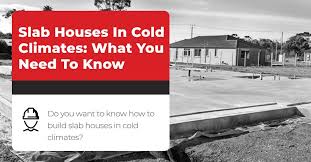When it comes to building a home in a region with a colder climate, the choice of foundation is a critical decision. Among the most practical and cost-effective options available is the concrete slab foundation. While slab houses are more common in warmer regions, they can be highly effective in cold climates when built with proper considerations and techniques. Whether you’re a homeowner, a contractor, or a builder, this guide will explain everything you need to know about slab houses in cold climates—including benefits, challenges, and strategies for success.
What is a Slab House?
A slab house is a home built on a single, solid concrete foundation rather than a basement or crawlspace. The concrete slab, typically four to six inches thick, is poured directly onto a layer of sand or gravel to improve drainage and stability. While this type of foundation is often associated with warm climates where the ground is less prone to freezing, with proper preparation and insulation, slab houses can also work well in cold climates.
Why Consider a Slab Foundation in a Cold Climate?
Here’s why many builders and homeowners opt for slab foundations even in chilly regions:
- Cost-Effectiveness: Building a slab foundation is generally less expensive compared to basements or crawlspaces. This offers significant savings in construction costs.
- Quick Construction: Concrete slabs take less time to construct, allowing projects to proceed faster even in shorter construction seasons typical of cold climates.
- Durability: Properly reinforced concrete slabs provide excellent durability and stability, making them a lasting foundation solution.
Challenges of Slab Houses in Cold Climates
Despite the benefits, there are specific challenges to building slab houses in regions with freezing temperatures. These include:
- Frost Heave:
When the ground freezes, it can expand and shift, potentially putting pressure on the slab and causing cracks or other damage.
- Subsurface Moisture:
Cold climates often result in increased ground moisture. Without adequate drainage, this moisture can compromise the slab’s integrity.
- Heat Loss:
A concrete slab can act as a thermal bridge, losing heat to the ground if not properly insulated, which leads to higher heating costs during winter.
Strategies for Building a Slab House in a Cold Climate
Building a slab house in a cold climate requires proper planning and attention to materials, design, and insulation. Here are six key strategies to ensure success:
1. Frost-Protected Shallow Foundation (FPSF)
A frost-protected shallow foundation is a highly effective solution for cold climates. By positioning insulation around the perimeter of the slab and extending it outward from the foundation walls, you can protect the ground beneath the slab from freezing. This design prevents frost heave and minimizes potential damage.
2. Proper Drainage Design
Good drainage is essential to prevent excess water from accumulating under and around the slab. Use a layer of compacted gravel or sand beneath the slab, and incorporate an efficient drainage system to direct water away from the foundation.
3. High-Quality Insulation
Insulating the slab, particularly along its perimeter, is critical to prevent heat loss. Rigid foam insulation is commonly used and is installed underneath and around the edges of the slab. This not only helps to retain heat but also prevents the concrete from becoming excessively cold, which can impact flooring materials inside the home.
4. Reinforce the Slab
Rebar (steel rods) and post-tension cables can be used to reinforce the slab, preventing cracks caused by ground movement. This also ensures the slab can bear the weight of the house over an extended period.
5. Install Radiant Floor Heating
Radiant floor heating is an excellent option for homeowners building slab homes in cold climates. This system involves embedding heating cables or hot water pipes into the slab, creating a warm floor surface that keeps the entire home cozy during the winter months.
6. Choose Durable Materials
Use durable concrete resistant to cracking and freeze-thaw cycles. When pouring the slab, ensure it meets local building standards for cold climates, and have it sealed to prevent moisture penetration.
Benefits of Slab Houses in a Cold Climate
When properly constructed, slab houses can offer several benefits in cold climates:
- Energy Efficiency: With appropriate insulation, slab houses can retain heat effectively, reducing energy bills during winter.
- Reduced Maintenance: Unlike basements, slabs do not have issues with flooding, mold, or pests, especially when built with proper moisture barriers.
- Accessibility: Slab houses sit closer to ground level, making them a great choice for homeowners who prefer fewer steps or have mobility concerns.
When Should You Avoid a Slab in Cold Climates?
While slabs can be suitable for cold climates in many cases, there are instances where they might not be ideal:
- High Water Tables: If the water table is too high, it can make drainage difficult and potentially cause moisture-related issues.
- Freeze-Thaw Cycles in Unstable Soil: Regions with extreme freeze-thaw fluctuations and clay-based soil might require additional precautions to prevent damage.
Consulting with a structural engineer or contractor familiar with local conditions is key to determining whether a slab foundation is the right fit for your project.
Final Thoughts
Building a slab house in a cold climate is entirely feasible when done with the right design, materials, and insulation. Not only is this type of construction cost-effective and efficient, but it also offers durability and long-term value with minimal maintenance requirements. However, it’s essential to address challenges like frost heave and heat loss with proper engineering and planning.
Whether you’re a homeowner considering building your dream house or a contractor advising your clients, understanding the unique aspects of slab foundations in cold climates will ensure your project is successful.
By incorporating the strategies outlined above, you can create a home that thrives even in the coldest conditions. Prioritize proper preparation, invest in quality materials, and enjoy the rewards of building a durable and efficient slab home.








